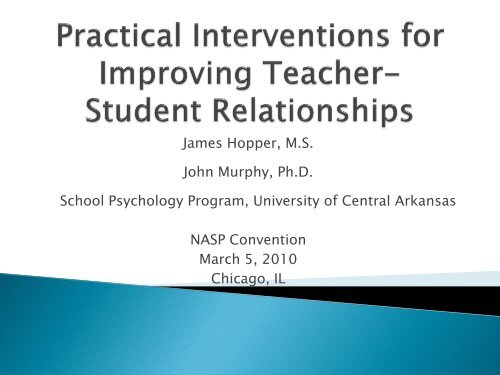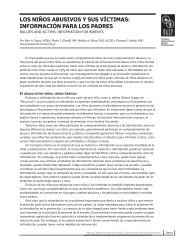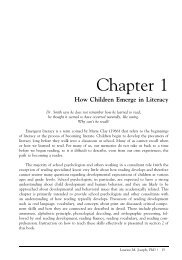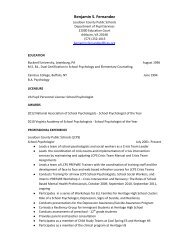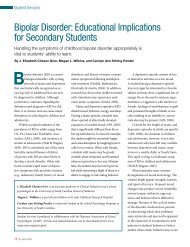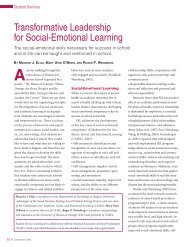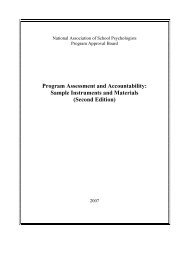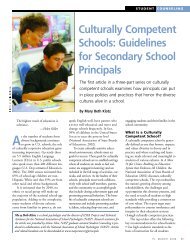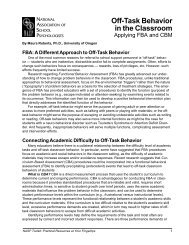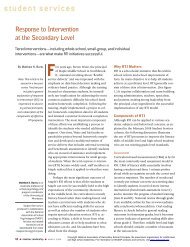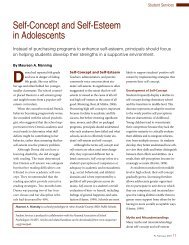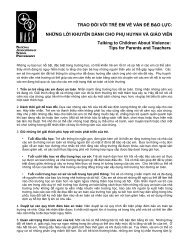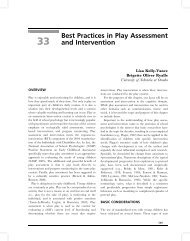Improving Student-Teacher Relationships
Improving Student-Teacher Relationships
Improving Student-Teacher Relationships
You also want an ePaper? Increase the reach of your titles
YUMPU automatically turns print PDFs into web optimized ePapers that Google loves.
James Hopper, M.S.<br />
John Murphy, Ph.D.<br />
School Psychology Program, University of Central Arkansas<br />
NASP Convention<br />
March 5, 2010<br />
Chicago, IL
� Provide an empirical rationale for attending to<br />
and enhancing teacher-student relationships<br />
(TSRs)<br />
� Introduce the “the change pie” and consider<br />
its relevance for TSRs<br />
� Consider some practical strategies for<br />
improving TSRs in schools
� Think of a teacher who you looked up to,<br />
respected, and considered very effective.<br />
◦ What year of school were you in when you had that<br />
teacher, what did they teach you that you still use<br />
to this day, etc.
� Several researchers have teased out the primary<br />
ingredients and characteristics of healthy<br />
teacher-student relationships. In general,<br />
positive relationships are characterized by<br />
different degrees of caring, connection, and<br />
conflict between students and teachers. The<br />
importance of these ingredients is magnified for<br />
students at risk for academic failure, socialbehavioral<br />
problems, and dropout (Baker, 1999;<br />
Hughes, Cavell, & Jackson, 1999; Lan & Lanthier,<br />
2003).
� <strong>Student</strong>s who experience positive TSR’s:<br />
◦ Get better grades and show higher levels of classroom<br />
motivation and participation (Crosnoe et al., 2004; Hamre &<br />
Pianta, 2005; Lan & Lanthier, 2003)<br />
◦ Demonstrate higher levels of social competence and<br />
appropriate behavior in the classroom (Hughes & Kwok,<br />
2006; Pianta, LaParo, Payne, Cox, & Bradley, 2002)<br />
◦ Display higher levels of participation, comfort,<br />
enjoyment, and acceptance by their peers (Hughes &<br />
Kwok, 2006)<br />
◦ Exhibit more appropriate behaviors (Murray & Greenberg,<br />
2001; Murray & Murray, 2004; Peisner-Feinberg et al., 2001)<br />
◦ Exhibit fewer inappropriate classroom behaviors<br />
(Crosnoe et al., 2004; Hamre & Pianta 2001; Ladd, Burch, & Buhs,<br />
1999; Lan & Lanthier, 2003)
� <strong>Student</strong>s with whom teachers perceive a closer<br />
relationship are rated higher on measures of<br />
academic achievement and social competence<br />
(Pianta & Stuhlman, 2004).<br />
� <strong>Teacher</strong>s interact differently with high-achieving<br />
and low-achieving students.<br />
◦ Low-achieving students experience fewer interactions,<br />
and less supportive ones, than their high-achieving<br />
peers (Baker, 1999). This is a major concern given that<br />
low-achieving students stand to benefit the most from<br />
caring and supportive relationships with their teachers<br />
(Hamre & Pianta 2005).
� TSR have been examined at all grade levels.<br />
(Kindergarten-graduate school) (Hamre & Pianta,<br />
2001; Crosby, George, Hatch, Robinson, & Thomas, 2005;<br />
Vulcano, 2007)<br />
� TSR has been found to be an important factor<br />
in the achievement of various “at risk” groups<br />
(Hamre & Pianta, 2005)<br />
� TSR have been found to have carry over<br />
effects for the children (Hamre & Pianta, 2001)
◦ What was it about this teacher that<br />
led to your positive impression?<br />
◦ What specific things did s/he do that<br />
enhanced the TSR for you and other<br />
students?
Hope<br />
15%<br />
Model/<br />
Technique<br />
15%<br />
Relationship<br />
30%<br />
Client<br />
40%
� How well does the change pie fit TSRs?<br />
� Which ingredients of the pie are relevant?<br />
� In what specific ways can schools, teachers,<br />
and school psychologists “apply the pie” to<br />
enhance TSRs at the school wide, classroom,<br />
and individual levels of service?<br />
� What can we do as school psychologists to
◦ Tailor the interventions to the school and its specific<br />
needs.<br />
◦ At the beginning of the year do a school wide in-service<br />
training about TSRs and strategies for starting off the<br />
school year well.<br />
� Try having the teachers call the children in their class a day or<br />
two before classes begin to say hello and let them know they<br />
are looking forward to working with them.<br />
� Have the younger kids draw what they did over the summer<br />
and invite them to the teachers desk the first day to talk<br />
about it. (5 minutes)<br />
� As new students enter their class, encourage teachers to do<br />
the same thing throughout the semester.
� Encourage teachers to connect electronically<br />
with children.<br />
� Encourage teachers, principals, and<br />
counselors to stay in contact with their<br />
children throughout the summer<br />
� Check & Connect programs<br />
� Continue these strategies and other similar<br />
ones throughout the year.
� Tailor it to the teacher and what they are<br />
comfortable with<br />
� Greet each student as they enter the room<br />
each day.<br />
� Allow the students to decorate their desks<br />
and classrooms with things that are<br />
meaningful to them and use these objects to<br />
open a dialogue.<br />
� Choose books for reading that demonstrate<br />
the benefits of a positive TSR.
� Tailor it to the student and to the teacher.<br />
� Talk with both of them together as a<br />
mediator.<br />
� These interventions need to be highly<br />
individualized.<br />
� Have the child help with a simple task or job<br />
within the classroom.<br />
� Encourage the child join a club the teacher<br />
sponsors.
� Work with “problem children” and their new<br />
teachers at the first of the year.<br />
� Meet with children and their teachers that<br />
come back from acute or long term<br />
psychiatric care<br />
� Invite children to discuss possible<br />
accommodations from IEP’s or 504 plans with<br />
their teachers before they are implemented<br />
� Invite children to be a part of developing their<br />
individualized behavior plans.
� Arrange in a small group and discuss a<br />
student you are currently working with that<br />
could benefit from having a stronger<br />
relationship with the teacher.<br />
◦ What is one small step you could take to help them<br />
improve their relationship
� Baker, J. A. (1999). <strong>Teacher</strong>-student interaction in urban at-risk classrooms: Differential behavior,<br />
relationship, quality, and student satisfaction with school. The Elementary School Journal, 100(1),<br />
57-70.<br />
� Crosby, W., George, A., Hatch, A., Robinson, R., Thomas, T., & Research for Action, I. (2006).<br />
Building Respectful Communities: Kensington <strong>Student</strong>s Examine Adult-<strong>Student</strong> <strong>Relationships</strong> in<br />
their New Small Schools. Writing to be Heard Series. Research for Action<br />
� Crosnoe, R., Johnson, M. K., & Elder, G. H. (2004). Intergenerational bonding in school:<br />
Thebehavioral and contextual correlates of student-teacher relationships. Sociology of Education,<br />
77(1), 60-81.<br />
� Hamre, B. K., & Pianta, R. C. (2001). Early teacher-child relationships and the trajectory of<br />
children’s school outcomes through eighth grade. Child Development, 72(2), 625-638.<br />
� Hamre, B. K., & Pianta, R. C. (2005). Can instructional and emotional support in the first-grade<br />
classroom make a difference for children at risk of school failure? Child Development, 76(5), 949-<br />
967.<br />
� Hughes, J. N., Cavell, T. A., & Jackson, T. (1999). Influence of the teacher-student relationship on<br />
childhood conduct problems: A prospective study. Journal of Clinical Child Psychology, 28(2), 173-<br />
184.<br />
� Hughes, J. N., & Kwok, O. (2006). Classroom engagement mediates the effect of teacher-student<br />
support on elementary students’ peer acceptance: A prospective analysis. Journal of School<br />
Psychology, 43(6), 465-480.
� Ladd, G.W., Birch, S. H., & Buhs, E. S. (1999). Children’s social and scholastic lives in kindergarten:<br />
Related spheres of influence? Child Development, 70(6), 1373-1400.<br />
� Lan, W., & Lanthier, R. (2003). Changes in students’ academic performance and perceptions of<br />
school and self before dropping out of schools. Journal of Education for <strong>Student</strong>s Placed At Risk,<br />
8(3), 309-332.<br />
� Murray, C., & Greenberg, M. T. (2001). <strong>Relationships</strong> with teachers and bonds with school: Social<br />
emotional adjustments correlates for children with and without disabilities. Psychology in the<br />
Schools, 38(1), 25-41.<br />
� Murray, C., & Murray, K. M. (2004). Child level correlates of teacher-student relationships: An<br />
examination of demographic characteristics, academic orientations, and behavioral orientations.<br />
Psychology in the Schools, 41(7), 751-762.<br />
� Peisner-Feinberg, E. S., Burchinal, M. R., Clifford, R. M., Culkin, M. L., Howes, C., Kagan, S. L., &<br />
Yazejian, N. (2001). The relation of preschool child-care quality to children’s cognitive and social<br />
development trajectories through second grade. Child Development, 72(5), 1534-1553.<br />
� Pianta, R. C., La Paro, K. M., Payne, C., Cox, M. J., & Bradley, R. (2002). The relation of kindergarten<br />
classroom environment to teacher, family, and school characteristics and child outcomes.<br />
Elementary School Journal, 102(3), 225-238.<br />
� Pianta, R. C., & Stuhlman, M. W. (2004). <strong>Teacher</strong>-child relationships and children’s success in the<br />
first years of school. School Psychology Review, 33(3), 444-458<br />
� .Vulcano, B. (2007Faculty Forum: Extending the Generality of the Qualities and Behaviors<br />
Constituting Effective Teaching. Teaching of Psychology, 34(2), 114-117.


